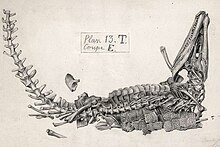| Anteophthalmosuchus Temporal range: Early Cretaceous, Barremian–Aptian PreꞒ Ꞓ O S D C P T J K Pg N | |
|---|---|

| |
| A. epikrator ("Dollo’s goniopholidid", specimen IRSNB R47), Musee d'Histoire Naturelle, Brussels | |
| Scientific classification | |
| Domain: | Eukaryota |
| Kingdom: | Animalia |
| Phylum: | Chordata |
| Class: | Reptilia |
| Clade: | Archosauria |
| Clade: | Pseudosuchia |
| Clade: | Crocodylomorpha |
| Clade: | Crocodyliformes |
| Clade: | Neosuchia |
| Family: | †Goniopholididae |
| Genus: | †Anteophthalmosuchus Salisbury & Naish, 2011 |
| Type species | |
| †Anteophthalmosuchus hooleyi Salisbury & Naish, 2011 | |
| Other species | |
| Synonyms | |
| |
Anteophthalmosuchus (meaning "forward-pointing eye crocodile") is an extinct genus of goniopholidid mesoeucrocodylian from the Early Cretaceous of southern England, eastern Spain, and western Belgium.
Discovery

The holotype specimen of Anteophthalmosuchus, from the Wealden Group of the Isle of Wight, includes a well-preserved skull and partial skeleton. This specimen has been known since 1904 and was identified as the "Tie Pits specimen" or the "Hooley specimen" after Reginald Walter Hooley, an amateur paleontologist who had described it in 1905. Hooley had originally attributed the specimen to the previously named species Goniopholis crassidens. Additional referred specimens include a partial disarticulated skeleton and a partial skull that may represent a juvenile specimen.
In 2011, Hooley's specimen was redescribed as a distinct genus and species of goniopholidid called Anteophthalmosuchus hooleyi. The genus name means "forward-pointing eye crocodile" because the specimen's eye sockets are positioned high on the skull and angle forward rather than to the side as in most other flat-skulled crocodyliforms, and the species name honors Hooley. Features that distinguish A. hooleyi from Goniopholis crassidens include the lack of a hole in the lower jaw called the mandibular fenestra, very wide supratemporal fenestrae (openings) on the skull table, and a bone above the eye socket called the palpebral that is small and does not extend over the socket as in some other goniopholidids.

Two specimens from Bernissart, Belgium, collectively referred to as "Dollo's goniopholidid", was referred to A. hooleyi in a 2016 redescription. The specimens, which consist of complete skeletons (one missing the skull) from the Sainte-Barbe Clays Formation, were originally referred to Goniopholis simus by Dollo. In 2016, they were recognized as specimens of A. hooleyi due to their distinctive eye sockets, among other defining characteristics of the species. While the Dollo specimens do not possess frontal bones that are pointed at the rostral end, a trait in 2011 to establish A. hooleyi as a distinct species, and also differs in the relative proportions of the occipital condyle and foramen magnum, the authors considered these traits invalid diagnostic characteristics, as they could be a consequence of age differences or preservational artifacts. However, in 2017, Dollo's goniopholidid was moved to a new species, Anteophthalmosuchus epikrator, based on comparisons with newly-discovered specimens from the Isle of Wight.
A second species, Anteophthalmosuchus escuchae, was first described and named by A.D. Buscalioni, L. Alcalá, E. Espílez and L. Mampel in 2013. It is known solely from the holotype AR-1-1097 which consists of a partial skull. It was collected from the early Albian-aged Escucha Formation, at Santa Maria Mine located in the municipality of Ariño, Teruel Province, of Aragon, along with the closely related Hulkepholis plotos.
Description
At an estimated over 3.5 metres (11 ft) in length, Anteophthalmosuchus would have been the largest crocodyliform in the Wealden faunal assemblage, larger than the contemporaneous species Hylaeochampsa vectiana, Leiokarinosuchus brookensis, and Vectisuchus leptognathus.
Phylogeny

Anteophthalmosuchus hooleyi was included in a phylogenetic analysis of goniopholidids that was published soon before the specimen was redescribed. The Hooley and Dollo specimens were found to be the closest relatives of a specimen called "Hulke's goniopholidid", now named Hulkepholis willetti. Below is a cladogram from that analysis:
| Neosuchia |
| ||||||||||||||||||||||||||||||||||||||||||||||||||||||||||||||||||||||||||||||||||||||||||||||||||||||||||||||||||||||||||||||||||||
References
- Steven W. Salisbury; Darren Naish (2011). "Crocodilians". In Batten, D. J. (ed.). English Wealden Fossils. The Palaeontological Association (London). pp. 305–369.
- Naish, Darren (2 December 2011). "The Wealden Bible: English Wealden Fossils, 2011". Tetrapod Zoology. Scientific American Blogs. Retrieved 5 December 2011.
- ^ Buscalioni, A.D.; Alcalá, L.; Espílez, E.; Mampel, L. (2013). "European Goniopholididae from the Early Albian Escucha Formation in Ariño (Teruel, Aragón, España)". Spanish Journal of Palaeontology. 28 (1): 103–122. doi:10.7203/sjp.28.1.17835. S2CID 73570030.
- ^ Martin, J.E.; Delfino, M.; Smith, T. (2016). "Osteology and affinities of Dollo's goniopholidid (Mesoeucrocodylia) from the Early Cretaceous of Bernissart, Belgium". Journal of Vertebrate Paleontology. 36 (6): e1222534. doi:10.1080/02724634.2016.1222534. hdl:2318/1635521. S2CID 89199731.
- ^ Naish, Darren (24 September 2012). "In pursuit of Early Cretaceous crocodyliforms in southern England: ode to Goniopholididae". Tetrapod Zoology. Scientific American Blogs. Retrieved 24 September 2012.
- ^ Ristevski, J.; Young, M.T.; de Andrade, M.B.; Hastings, A.K. (2017). "A new species of Anteophthalmosuchus (Crocodylomorpha, Goniopholididae) from the Lower Cretaceous of the Isle of Wight, United Kingdom, and a review of the genus". Cretaceous Research. 84: 340–383. doi:10.1016/j.cretres.2017.11.008.
- De Andrade, M. B.; Edmonds, R.; Benton, M. J.; Schouten, R. (2011). "A new Berriasian species of Goniopholis (Mesoeucrocodylia, Neosuchia) from England, and a review of the genus". Zoological Journal of the Linnean Society. 163: S66–S108. doi:10.1111/j.1096-3642.2011.00709.x.
| Neosuchia | |||||||||||||||||||||||||||||||
|---|---|---|---|---|---|---|---|---|---|---|---|---|---|---|---|---|---|---|---|---|---|---|---|---|---|---|---|---|---|---|---|
| |||||||||||||||||||||||||||||||
| |||||||||||||||||||||||||||||||
| |||||||||||||||||||||||||||||||
| |||||||||||||||||||||||||||||||
| Taxon identifiers | |
|---|---|
| Anteophthalmosuchus | |
| Anteophthalmosuchus epikrator | |


